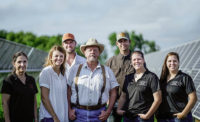Clay Edwards, sustainability program lead for Cargill, and Jeff Fitzpatrick, BeefUp Sustainability Signature Program lead for Cargill, share some details about the company's recent developments in its regenerative agriculture efforts.
Provide an overview of the Cargill RegenConnect program — its mission and goals.
In 2021, Cargill launched a new regenerative agriculture program that pays farmers for improved soil health and positive environmental outcomes, including payment per metric ton of carbon sequestered. Called Cargill RegenConnect, the program helps scale the voluntary adoption of regenerative agriculture practices and connects farmers to the growing carbon marketplace. The program is currently available in 24 states and for the 2023-24 enrollment year, U.S. farmers can earn $35 per metric ton of carbon sequestered per acre. Recently, we expanded the program to growers in France, Germany, Poland and Romania. Cargill RegenConnect is one of the many programs that Cargill supports in its efforts to advance regenerative agriculture practices across 10 million acres of farmland in North America by 2030. Some of our other partners and programs include the Soil Health Institute, the Soil Carbon Partnership, the Soil and Water Outcomes Fund and the Practical Farmers of Iowa. You’ll find more details on these and other efforts here. — Clay Edwards
In what ways do the Cargill RegenConnect program’s practices/goals intersect with animal agriculture and the rest of the protein supply chain?
There’s a direct intersection as the Cargill RegenConnect program, which focuses on improving the environmental footprint of row-crop production, is working to lower the carbon footprint of feed production. But it’s not our only initiative focused on this important work. Our BeefUp Sustainability effort seeks to reduce greenhouse gas emissions throughout our North American beef supply chain by 30% by 2030. Through BeefUp Sustainability, we are collaborating with farmers, ranchers, conservation organizations, and like-minded companies to make this goal a reality. Our recent announcements with Taco Bell and Nestlé illustrate this work, as together, we’re working to scale the adoption of voluntary conservation practices and support thousands of cattle producers as they implement regenerative practices. Alongside our work targeting grazing management, we’re also helping to scale more sustainable feed production practices, investing in innovation and working to reduce food waste. — Jeff Fitzpatrick
With a recent expansion to the EU building on the foundation of Cargill’s 10 million-acre regenerative ag commitment in North America, how does this move expand the effort’s global vision?
Cargill has global goals to reduce greenhouse gas emissions in our supply chain, achieve positive water impact in our supply chains, and improve farmer livelihoods. A key pathway for achieving these goals and building resilience for long-term food security is through regenerative agriculture. Our ambition is to make regenerative agriculture common place across our globally supply chains and our expansion to Europe will support progress on these goals. — Clay Edwards
What regulatory and market forces are powering the Cargill RegenConnect program?
Cargill’s unique position in the supply chain allows us to connect farmers with some of the world’s largest companies, which are counting on agricultural supply chains — to achieve their sustainability goals. Farmers must lead the way, but they need the tools, resources — and importantly, market access and financial drivers — to make the shift to regenerative agriculture. As a trusted partner, Cargill is helping farmers be successful now — and prepare for the future. — Clay Edwards




Report Abusive Comment